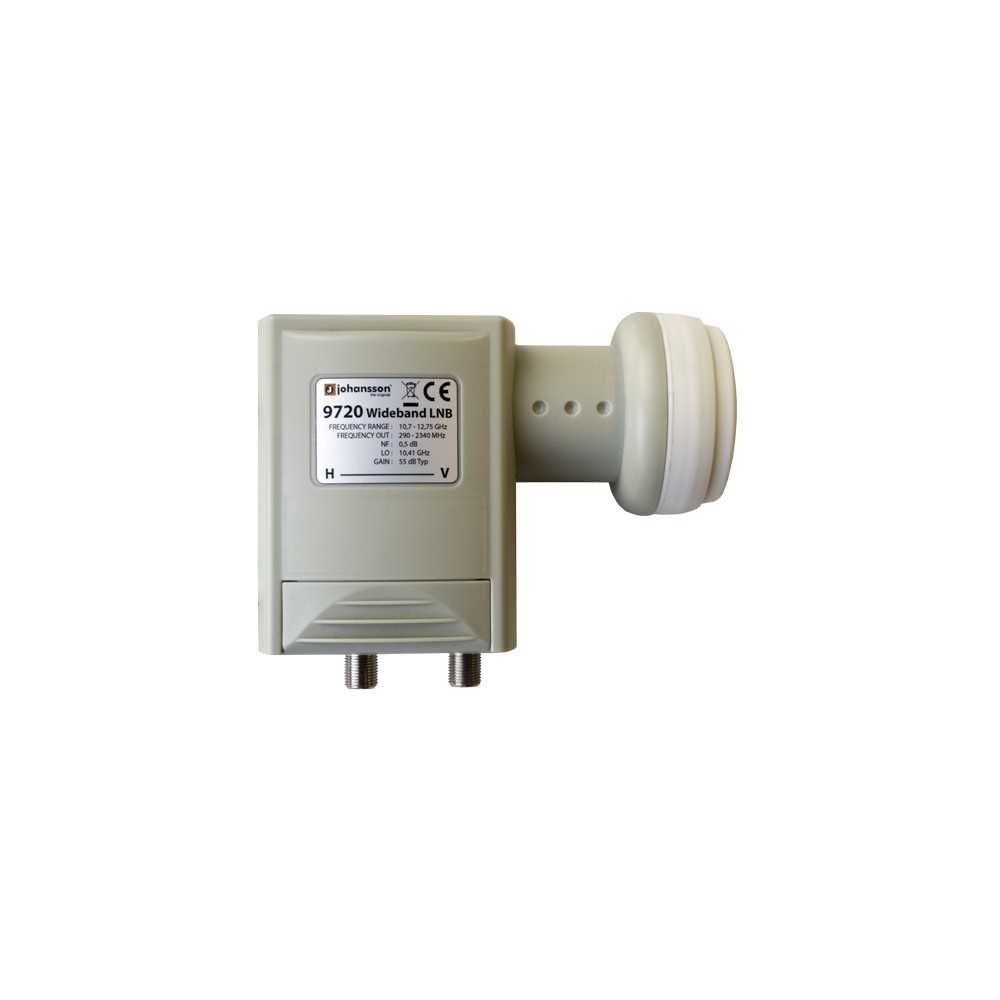Palydovinio plačiajuosčio ryšio keitiklis LNB Johansson 9720
33,71 €
Su PVM
5 Vnt.
TP-14520864-EU
 Saugus Atsiskaitymas
Saugus Atsiskaitymas
El. Bankininkystė, Grynais arba Visa - Mastercard
 Nemokamas Pristatymas
Nemokamas Pristatymas
Nemokamas pristatymas užsakymams nuo 79€.
 Prekių Grąžinimas
Prekių Grąžinimas
Suteikiame 14 dienų pinigų grąžinio garantiją
Satellite broadband converter LNB Johansson 9720
The Johansson 9720 broadband LNB is designed for a new and more efficient way of distributing satellite signals. While in conventional universal LNBs the Ku band is divided into low and high band for vertical and horizontal polarization, a broadband LNB converts each polarization as a whole, with only 2 cables coming out of the LNB - one for the complete band with vertical polarization and one with complete horizontal polarization. This is a much more efficient way of distribution with the following advantages:
• Fewer connections and cable connections, leading to a more reliable system
• Lower costs for used parts
• Lower energy consumption for all distribution products
The output signal can then be processed by a programmable amplifier with frequency conversion of multiplexes (eg Johansson 9780), or received by satellite receivers with broadband compatible tuners, or converted (using a Johansson 9646 converter) to 4 classic sat. MF band Quatro and then distribute to sat. receivers that are not compatible with broadband.
Technical parameters :
- input zone: Ku
- input frequency: 10700 to 12750 MHz
- outputs: 2 (1x V polarization + 1x H polarization)
- output frequency: 290 to 2340 MHz
- local oscillator frequency: 10410 MHz
- conversion gain: typically 55dB
- noise figure: typically 0.5dB
- cross polarization suppression: 25dB
- output power: -30dBm *
- DC supply voltage: 9 to 20 V / DC
- electricity consumption power: <1W
- operating temperature: -40 to + 60 ° C
- diameter of mounting sleeve: 40mm
- dimensions: 135 x 120x 60mm
* output power depends on the size of the antenna and EIRP transponder on the satellite
The Johansson 9720 broadband LNB is designed for a new and more efficient way of distributing satellite signals. While in conventional universal LNBs the Ku band is divided into low and high band for vertical and horizontal polarization, a broadband LNB converts each polarization as a whole, with only 2 cables coming out of the LNB - one for the complete band with vertical polarization and one with complete horizontal polarization. This is a much more efficient way of distribution with the following advantages:
• Fewer connections and cable connections, leading to a more reliable system
• Lower costs for used parts
• Lower energy consumption for all distribution products
The output signal can then be processed by a programmable amplifier with frequency conversion of multiplexes (eg Johansson 9780), or received by satellite receivers with broadband compatible tuners, or converted (using a Johansson 9646 converter) to 4 classic sat. MF band Quatro and then distribute to sat. receivers that are not compatible with broadband.
Technical parameters :
- input zone: Ku
- input frequency: 10700 to 12750 MHz
- outputs: 2 (1x V polarization + 1x H polarization)
- output frequency: 290 to 2340 MHz
- local oscillator frequency: 10410 MHz
- conversion gain: typically 55dB
- noise figure: typically 0.5dB
- cross polarization suppression: 25dB
- output power: -30dBm *
- DC supply voltage: 9 to 20 V / DC
- electricity consumption power: <1W
- operating temperature: -40 to + 60 ° C
- diameter of mounting sleeve: 40mm
- dimensions: 135 x 120x 60mm
* output power depends on the size of the antenna and EIRP transponder on the satellite


